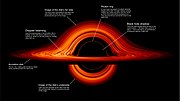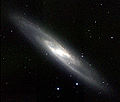Search results
Appearance
The page "Disk population star" does not exist. You can create a draft and submit it for review or request that a redirect be created, but consider checking the search results below to see whether the topic is already covered.
- globular star clusters. Two main divisions were defined as Population I star and population II, with another newer, hypothetical division called population III...35 KB (3,549 words) - 09:04, 4 October 2024
- protoplanetary disk is a rotating circumstellar disc of dense gas and dust surrounding a young newly formed star, a T Tauri star, or Herbig Ae/Be star. The protoplanetary...21 KB (2,138 words) - 13:56, 3 September 2024
- frequently a star. Friction, uneven irradiance, magnetohydrodynamic effects, and other forces induce instabilities causing orbiting material in the disk to spiral...33 KB (4,352 words) - 06:19, 17 September 2024
- grouped into Population I (young) and Population II (old). Location: In the Milky Way galaxy the groups are described as thin disk, thick disk, central bulge...4 KB (662 words) - 12:21, 25 January 2024
- Protostar (redirect from Proto-star)nebula L1527 (2022). Stellar birthline Pre-main-sequence star Protoplanetary disk Quasi-star Star formation Stellar evolution Stahler, S. W. & Palla, F....11 KB (1,238 words) - 17:40, 18 June 2024
- Accretion disk – Structure formed by diffuse material in orbital motion around a massive central body Blitzar – Hypothetical type of neutron star Thorne–Żytkow...9 KB (1,033 words) - 05:19, 23 September 2024
- protoplanetary disk and powered mainly by the conversion of gravitational energy. The period of gravitational contraction lasts about 10 million years for a star like...147 KB (16,412 words) - 12:11, 7 September 2024
- Galactic disc (redirect from Disk star)A galactic disc (or galactic disk) is a component of disc galaxies, such as spiral galaxies like the Milky Way and lenticular galaxies. Galactic discs...9 KB (1,275 words) - 22:58, 30 July 2024
- The thick disk is one of the structural components of about 2/3 of all disk galaxies, including the Milky Way. It was discovered first in external edge-on...12 KB (1,462 words) - 22:17, 18 July 2024
- having been gathered up by the disk, and the protostar becomes a classical T Tauri star. The latter have accretion disks and continue to accrete hot gas...40 KB (4,411 words) - 22:19, 21 September 2024
- within three categories: unidirectional regeneration, disk-dependent bidirectional regeneration, and disk-independent bidirectional regeneration. In each case...39 KB (3,985 words) - 00:43, 4 July 2024
- Zeta Reticuli (category Bright Star Catalogue objects)3 kly (0.4 kpc) from the plane of the galactic disk. This likely puts them outside the thick disk population of stars. Zeta Reticuli has no known planets...24 KB (2,161 words) - 14:52, 14 October 2024
- The West Indian brittle star, Ophiocomella ophiactoides, frequently undergoes asexual reproduction by fission of the disk with subsequent regeneration...32 KB (3,473 words) - 13:26, 24 June 2024
- Glossary of astronomy (redirect from Thin disk population)6 light-years. accretion disk A roughly circular mass of diffuse material in orbit around a central object, such as a star or black hole. The material...161 KB (18,470 words) - 08:08, 9 October 2024
- HD 140283 (redirect from Methuselah star)that of the Sun. It is one of the closest metal-poor (population II) stars to Earth. The star was already known by 1912 when W. S. Adams measured its...14 KB (1,573 words) - 19:59, 10 October 2024
- motion, have led to the designation "intermediate population II star", between a halo and disk star. However, some recently published scientific papers...55 KB (5,196 words) - 17:08, 9 October 2024
- Flame Nebula (category Star-forming regions)central star. Within the nebula and surrounding the central hot star is a cluster of young, lower-mass stars, 86% of which have circumstellar disks. X-ray...9 KB (970 words) - 00:28, 23 August 2024
- Elliptical galaxy (section Star formation)with their large-scale disks, and ES galaxies with their intermediate scale disks, a subset of the "early-type" galaxy population. Most elliptical galaxies...17 KB (1,907 words) - 05:42, 12 September 2024
- brightness variability are clumps (protoplanets and planetesimals) in the disk surrounding T Tauri stars. Their spectra show a higher lithium abundance...9 KB (928 words) - 20:03, 20 March 2024
- HN Pegasi (category Circumstellar disks)This star displays an emission of infrared excess that suggests there is a circumstellar disk of debris in orbit. HN Pegasi is most likely a thin disk population...12 KB (921 words) - 01:42, 8 September 2024
- great star rose, near ten hours late, the sun rose close upon it, and in the center of its white heart was a disk of black. Over Asia the star had begun
- "milky circle"). From Earth, the Milky Way appears as a band because its disk-shaped structure is viewed from within. Galileo Galilei first resolved the
- sufficient energy has been exchanged to form a disk. These galaxies resemble their initial elliptical shape before star formation. Other theories speculate that

















